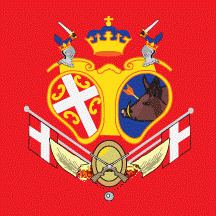Restoration of Ottoman rule October 1813 | Establishment of government 1804 Disestablished 1813 | |
 | ||
Government Autonomous principality 1815 24,440 km² (9,436 sq mi) | ||
Revolutionary Serbia (Serbian: Устаничка Србија) or Karađorđe's Serbia (Карађорђева Србија) refers to the state established by Serbian revolutionaries in Ottoman Serbia (Sanjak of Smederevo) after successful military operations against the Ottoman Empire and establishment of government in 1805. The Sublime Porte first officially recognized the state as autonomous in January 1807, however, the Serbian revolutionaries rejected the treaty and continued fighting the Ottomans until 1813. Although the uprising was crushed, it was continued by the Second Serbian Uprising in 1815, which resulted in the creation of the Principality of Serbia, as it gained semi-independence from the Ottoman Empire in 1817.
Contents
Stratimirović's Memorandum
Ičko's Peace
Between July and October 1806 Petar Ičko, an Ottoman dragoman (diplomat) and representative of the Serbian rebels, negotiated a peace treaty known in historiography as "Ičko's Peace". Ičko had been sent to Constantinople twice in the latter half of 1806 to negotiate peace. The Ottomans seemed ready to grant Serbia autonomy following rebel victories in 1805 and 1806, also pressured by the Russians, who had taken Moldavia and Wallachia; they agreed to a sort of autonomy and clearer stipulation of taxes in January 1807, by which time the rebels had already taken Belgrade. The rebels rejected the treaty and sought Russian aid to their independence, while the Ottomans had declared war on Russia in December 1806. A Russian-Serbian alliance treaty was signed on 10 June 1807.
Russian–Serbian Alliance
On 10 July 1807, the Serbian rebels under Karađorđe signed an alliance with the Russian Empire during the First Serbian Uprising. After the Ottoman Empire had allied itself with Napoleon in late 1806, and was attacked by Russia and Britain, it sought to meet the demands of the Serbian rebels. At the same time, the Russians offered the Serbs aid and cooperation. The Serbs chose alliance with the Russians over autonomy under the Ottomans (as set by the "Ičko's Peace"). Karađorđe was to receive arms, and military and medical missions, which proved to be a turning point in the Serbian Revolution.
Proclamations
Government
Rule was divided between Grand Leader Karađorđe, the Narodna Skupština (People's Assembly) and the Praviteljstvujušči Sovjet (Ruling Council), established in 1805.
Ruling Council
The Ruling Council was established by recommendation of the Russian Minister for Foreign Affairs Chartorisky and on the proposal of some of the dukes (Jakov and Matija Nenadović, Milan Obrenović, Sima Marković). The idea of Boža Grujović, the first secretary, and Matija Nenadović, the first president, was that the council would become the government of the new Serbian state. It had to organize and supervise the administration, the economy, army supply, order and peace, judiciary, and foreign policy.
Ministries
In 1811, the government system was reorganized, with the formation of ministries (popečiteljstva) instead of nahija-representatives.
